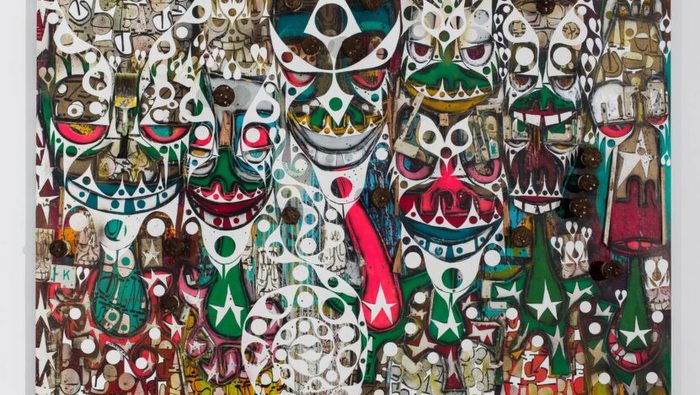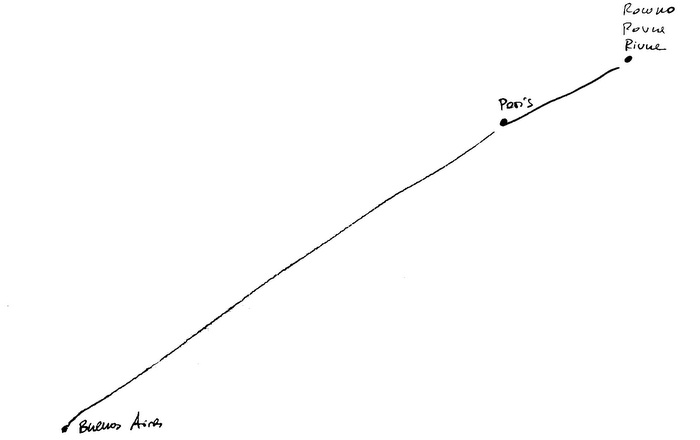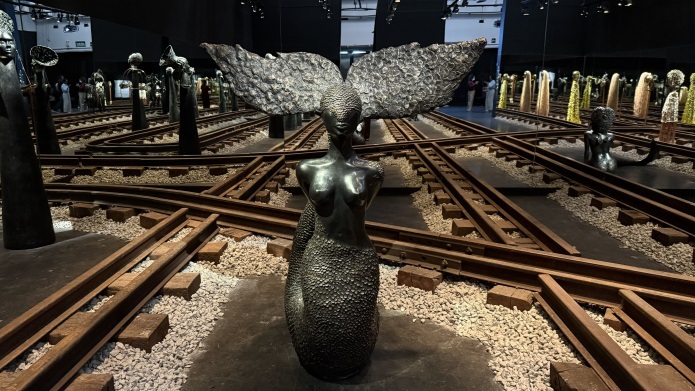Phil Frost has a distinctive individual style in which he mixes patterns, colours and textures to create an instantly recognisable personal language. His works contain multiple layers populated with characteristic elements such as heads on elongated necks, collage, letters and drawings made with white correction fluid or spray paint, overlaid with found objects such as comic strips, coins, fragments of registration plates, house numbers, soda cans, spools and the like.
As the exhibition curator Fernando Francés explains, the artist's work contains an ancestral mysticism, to the extent that his baroque labyrinth of texts, images, portraits and objects can only be fully understood from the heart. The symbols in his work transport it to a realm that stretches the limits between reason and the humanly inexplicable
Frost's works are characteristically formed of multiple layers in which different colours and textures are combined with white patterns of letters and/or symbols. Mixed-media paintings (ink, acrylic, oil, pencil crayon and collage) and the sculptural elements overlaid with found objects are additional hallmarks of his work.
As a perfectionist, the artist locks himself away in his studio and it can take him several years to consider a work finished because of the numerous layers each piece contains. The first layer is a collage of newspaper clippings or comic strips, which he then paints over with acrylic and spray paint before adding a final layer of his signature Tippex, which he uses to create tribal masks. The correction fluid often appears to form a code or language, composed of letters, hearts, dots and faces, reminiscent of tribal and indigenous art. These symbols, which the artist refers to as "glyphic distinctions", are painted on top of heavily textured backgrounds, as we see in works like Untitled (2007-2014), Untitled (1999), Accumulated Field of Perceptive Experience (2002-2014) and others.
The origin of these powerful graphical patterns stems from his interest in different dialects and languages, giving rise to the personal typography he uses to write in numerous hybrid languages, both real and imaginary. These patterns have an archaic code composed of symbols, letters, hearts, dots and mask-like forms whose appearance blurs the lines between modern and primitive, between abstraction and representation.
Frost has gradually honed his technique to the point of being able to draw sound constructions, creating linear forms interlaced with the typographies and with the found objects and figurative busts or heads isolated on the pictorial plane.
Emerging between the layers in his works are figures with elongated faces and stylised necks that recall totems or tribal masks. These characters are the formal elements that articulate his complex compositions.
His paintings also possess a vibrant palette of colours, ranging from shades of grey, brown, red, yellow, pink, orange and green to other hues such as gold, magenta and blue.
Phil Frost spent his childhood in rural areas of West Massachusetts, finding axes and spear heads in his explorations of the local crop fields and Indian forests. This provided him with inspiration when he started working with found objects, as a metaphor for how the present creates an experience in time and in the space that is formed physically and intuitively from one's surroundings.
Disparate objects rescued from obsolescence and oblivion form the basis of the artist's complex structures which seem repetitive yet are completely new, spiritual compositions with an internal vibration that reflects his profound pantheism. We find this for example in Two Busts of Liminal Experience (2007-2014) in which the artist has included a ladder, in Accumulated Field of Perceptive Experience (2002-2014) overlaid with glass bottles, and in Collapse of Fleeting Experience (2004-2014) with its boxing gloves and baseball bat.
Featured in Plotting Upon the Passage of Time are some of his most recent works—a selection of paintings on wooden doors—finished in 2021 and receiving their first public showing on this occasion. These doors, which the artist found and altered for reuse as supports for his paintings, bring together all the characteristic recurring elements in his iconography: heads on elongated necks, collage, letters and drawings made with correction fluid or spray paint, a totemic appearance, over-elaborateness and an entire collection of found objects, such as comic strips, coins, fragments of registration plates, numbers, cans, spools, bottles, paint brushes, a ladder and baseball bats, which will introduce visitors to Phil Frost's original and highly personal universe.
The show also includes a selection of works from his earliest period made in collaboration with other artists and influenced by pop culture and urban art: for example, the works on paper made with KAWS, featuring the silhouette of one of his characteristic COMPANIONS; and the painting on wood made in collaboration with Shepard Fairey (OBEY) that includes his famous character André the Giant, a portrait of the famous wrestler that subsequently became the OBEY GIANT global campaign.
Phil Frost (Jamestown, New York, 1973) is a self-taught artist who became interested in the plastic arts through his contact with the graffiti underground. His solo shows include Ellipse of Passage, Galería Javier López & Fer Francés, Madrid (2018); Magnetic Shift, Corning Tower Concourse Level – Empire State Plaza, Albany, New York (2016); The Solace of The Sword, Ace Gallery, Los Angeles (2013); mALORsUDas sOlarMB: Selected Works by Phil Frost, University Art Museum, Albany, New York (2004); Soalmb Seven, Pennsylvania Academy of Fine Art, Philadelphia, Pennsylvania (2002); Untitled, Spiral Museum Cultural Center, Tokyo (2001); and Bolsar 7, Jack Shainman Gallery, New York (1998).
Phil Frost won the Pernod Award in 1996 and the Pollock-Krasner Foundation Award in 2004. He is also the recipient of grants from the New York Foundation for the Arts and the Louis Comfort Tiffany Foundation.
4 March – 22 May 2022















